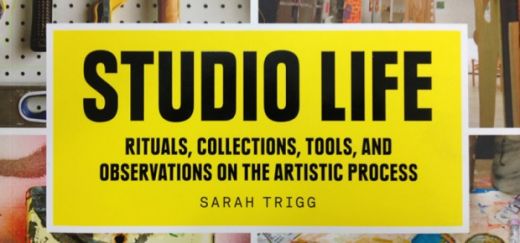Studio Life: Rituals, Collections, Tools and Observations on the Artistic Process
Sarah Trigg

Princeton Architectural Press
256 pages
Reviewed by Cara Despain
Like a piece of artwork, the book is similarly experienced conveniently as something complete—a handy, self-contained compendium of one-hundred artists’ studios with brief descriptions and photos of some of their strange and practical items. But the book represents a far greater endeavor. Over the course of three years, Trigg traveled to numerous cities visiting multiple artists in each to photograph coveted objects, tools, furniture, photos and messes in their studios. In total, she visited over two hundred studios across the country—some were those of very well known artists, some not at all.
What makes her work refreshing is her democratic approach to including artists. She met with people she knew already, had studied with, or knew their work and also with artists whom she had never heard of or met. Though she would often follow recommendations that led to unanticipated and serendipitous visits and did not always have prescribed plans or results, she made an effort to reflect the demographics of the cities she visited—at least initially. She took into consideration the project’s balance of notoriety, ethnicity, gender and even the proportion of artists she included in relation to the population the city she visited. While there are many established artists in the book, Studio Life does not privilege them. The visiting process appears to have unfolded somewhat organically, which enabled exploratory documentation. This is apparent in the book overall—with such a thorough collection process resulting in so much material to work with that the sheer quantity outpaces prolonged ruminations on each studio. It reads somewhat like a field guide—brief and direct, with numerous entries full of informative and anecdotal tidbits that you can almost imagine reading aloud from the passenger side of a car on a cross-continental road trip.
It’s inevitably a personal account of her experience shooting the studios—in the introduction she outlines the process, and several organizational themes that emerged from it that the book is loosely organized around. They are: mascots, collected objects, makeshift tools, rituals, residue, and habitat. Focusing on more subtle activities and objects—Trigg also notes in the introduction that it is these details and not the artwork, architecture, or traditional tools that will feature in the visits—is an interesting, if unexpected approach to a book on this topic. It attests to another personal facet of the project: Trigg herself is an artist. Much of the curiosity and sensitivity to the by-products of art-making can be attributed to her perspective as an artist looking at the studios of other artists. When this perspective is considered, it colors the book in a different light. The expectation of glossy spreads showing the sprawling production spaces of artists is not met here. This aims the focus more specifically on the secondary objects in artists’ lives, the accretions of their practice—something a fellow artist will instantly recognize and relate to. Though many others share this curiosity, Studio Life feels like a book for artists.
Though there are several longer observations, the majority of the visits are confined to one page or two pages including the description and images. This makes some sense given the way the project unfolded—after embarking on a large investigation that sought to avoid a hierarchical system of categorization, it would be hard to decide to cut any visits out. The projects that are not in the printed volume are included on Trigg’s website, The Goldminer Project, and in some ways the brevity that can make for un-sticking impressions in the book is perhaps better suited for the online format. While there are certainly concise and interesting short pieces in print like Conrad Bakker or Allison Shulnik, visits that have a few more pages like Kevin Wolff, David Brooks and Jim Shaw allow more time for the anthropological intention of the project to really shine. Those printed profiles are the ones most satisfying to read as a book, but it would be hard to get the larger sense of the project without also presenting the great number of artists interviewed in some form.
Though in one regard it may have benefited the book to have the themes more clearly delineated in something like chapters or sections, it was still interesting to see it unfold naturally in a meandering way that was ultimately striking in its consistency. Again, this underscores the lives of artists and the anthropological activity Trigg sought to uncover with her very thorough venture. It’s a unique way to discuss what a studio practice is like for artists, and also to express some of the vast variations within it. What might be most fascinating, though, are the peculiarities we share. They seem to emerge as both the core and the inception of her project, and her personal and sincere interest is apparent.










